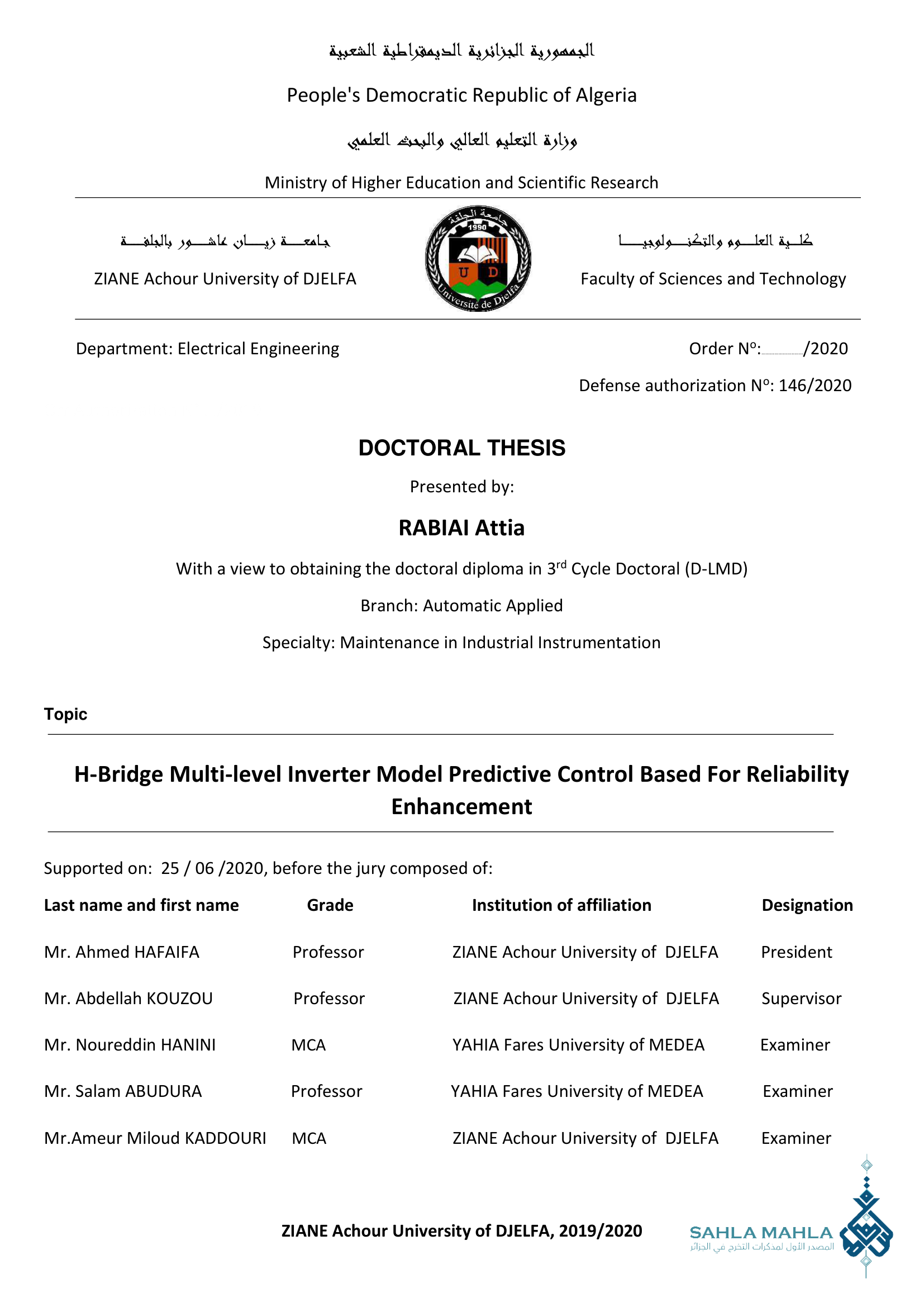H-Bridge Multi-level Inverter Model Predictive Control Based For Reliability Enhancement
General Information:
DOCTORAL THESIS |
Level |
H-Bridge Multi-level Inverter Model Predictive Control Based For Reliability Enhancement |
Title |
Maintenance in Industrial Instrumentation |
Specialty |
Cover Page:
Outline:
General introduction CHAPTER I: State of the art on predictive control 1.1 Introduction 1.2 Historical summary of the development of predictive control 1.3 Predictive control methodology 1.4 Elements of the predictive control 1.4.1 The prediction model 1.4.1.1 The process model 1.4.1.1.a The impulse response 1.4.1.1.b The index response 1.4.1.1.c The transfer function 1.4.1.1.d The stat space model 1.4.1.2 Disturbance model 1.4.1.2.a Optimization method 1.4.1.2.b The sliding horizon 1.4.2 The objective function 1.4.3 Reference trajectory 1.4.4 Predictive control modeling 1.4.4.1 The knowledge model 1.4.4.2 Input-output global behavior model 1.5 The optimization 1.5.1 Types of constraints 1.5.2 Optimization under constraints 1.5.3 Concept of feasibility 1.5.4 Choice of horizons 1.6 The prediction horizon Np 1.7 The order horizon N 1.8 The weighting factor 2 1.9 Conclusion CHAPTER II: Studies of the different topologies of multi-level inverters II.1 Introduction II.2 History and advantages of multi-level inverter II.2.1 Historical overview II.2.2 Multi-level inverter benefits II.3 Different multi-level inverter topologies II.3.1 Neutral point clamped multi-level inverter II.3.1.1 Advantages II.3.1.2 Inconveniences II.3.1.3 Other variants of neutral point clamped inverter topology II.3.2 Flaying capacitor inverter II.3.2.1 Advantages II.3.2.2 Inconveniences II.3.3 Cascaded h-bridge multi-level inverter II.3.3.1 Advantages II.3.3.2 Inconveniences II.4 Application of multi-level inverters in the industry II.4.1 Application in the field of rail traction and electric vehicle II.4.2 Application in the supply of on board networks and propulsion of maritime buildings II.4.3 Application in the field of electricity grids II.4.4 Application in the area of power supply for electrical machines II.5 Comparison of different multi level inverter topologies II.6 Conclusion CHAPTER III: Control strategies for three phase VSI and multi-level h-bridge inverter III.1 Introduction III.2 Multi level inverter control principle III.3 Multi level inverter modulation III.3.1 Presentation of the two level voltage source inverter III.3.2 Description and operation of two level three phase inverter III.3.3 Vector modelling of two level voltage source inverter III.4 Space vector modulation control III.4.1 Space vector pulse width modulation Principle III.4.2 Definition of the reference vector III.4.3 Sector determination III.5 Approximation of voltage vector control III.5.1 Duration times III.5.2 Definition of the state vector sequences III.5.3 The dwell times III.6 Basic principle of space vector PWM of a three level inverter III.6.1 The switching stats III.6.2 The duty cycles III.6.2.1 The duty cycles in the first region III.6.2.2 The duty cycles in the second region III.6.2.3 The duty cycles in the third region III.6.2.4 The duty cycles in the fourth region III.7 The modulation algorithm III.7.1 Sequencing of the switching times III.7.1.1 Sequencing of switching states for sector A III.7.1.1.a Switching states of first region III.7.1.1.b Switching states of second region III.7.1.1.c Switching states of third region III.7.1.1.d Switching states of fourth region III.8 Model predictive current control III.8.1 Predictive control strategy III.8.2 Discrete time model III.8.3 The predictive model III.8.4 The cost function III.8.4.1 The choice of cost function III.8.4.2 Minimization of cost function III.8.5 Model predictive current control algorithm III.9 Conclusion CHAPTER IV: Predictive control strategy for VSI and multi level h-bridge inverter IV.1 Introduction IV.2 Presentation of Matlab environment IV.3 Simulation results IV.3.1 The predictive control strategy for three-phase two-level voltage source inverter IV.3.1.1 Sinusoidal reference IV.3.1.2 Reference tracking IV.3.1.2.1 The first test for one step change from 5A to 10A at time 0.05s IV.3.1.2.2 The second test for two step changes from 5A to 2A at 0.05s than from 2A to 10A at 0.1s IV.3.1.3 Stability of the control algorithm of a two-level VSI subject to a variable DC-link voltage,Vac input IV.3.1.4 Comparison of the model and actual system parameters IV.3.1.5 Comparison between space vector PWM control and predictive control IV.3.1.6 Evaluating system performance IV.3.2 Model predictive control strategy for a three-phase three level h-bridge inverter IV.3.2.1 The first test with sampling time of T, = 10 μs IV.3.2.2 The second test with sampling time of Ts = 100 μs IV.6 Conclusion General conclusion Bibliographical references
Download The Thesis:



